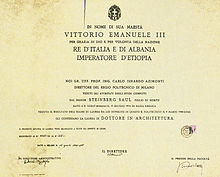Saul Steinberg

Saul Steinberg (born June 15, 1914 in Râmnicu Sărat , † May 12, 1999 in New York ) was a Romanian - American draftsman and caricaturist . He was best known for his cartoons and cover pictures for The New Yorker magazine . A cover picture was also created for this magazine (published on March 29, 1976), which later became a popular poster motif: a perspective-distorted map that depicts part of the globe starting from a New York street and as a graphic idea for any other location was modified.
Life
Steinberg was born in 1914 in Râmnicu Sărat, Romania, as the son of bookbinder and cardboard manufacturer Maurice Steinberg and his wife Rosa Jacobson Steinberg. He began studying sociology and psychology at the University of Bucharest . In 1932 he moved to Milan , where he moved to the Politecnico in 1933 to study architecture , which he completed in 1940. During his studies he began to draw and published his drawings in the humorous weekly newspaper Bertoldo , which he founded in 1936 with the journalist Giovannino Guareschi . He never worked as an architect.
In 1941 he emigrated to the USA via Portugal with a passport whose stamp he had forged himself, but was deported from Ellis Island to the Dominican Republic because the admission quota for Romanians was already exhausted. From there he sent some of his cartoons to The New Yorker magazine , hoping for inclusion in the US, which in fact happened. Since then he has remained a permanent contributor to the New Yorker . The abstract expressionist painter Hedda Sterne became his wife in 1943. They separated in the 1970s but never got divorced.
During the Second World War , Steinberg had to teach Maoist guerrillas in China how to blow bridges and then fled over the mountains to India. Then he was sent to North Africa and Italy by William Donovan , the head of the US Intelligence Service Office of Strategic Services (OSS). There he was supposed to draw cartoons that ridiculed the Nazis and fascists. The caricatures were printed in the OSS newspaper Das Neue Deutschland and dropped behind enemy lines.
After the war, his style became more abstract, philosophical and symbolic.
He created the collage The Americans for the American pavilion at the 1958 World Exhibition in Brussels . It consists of eight wall panels with a total length of 70 meters. Steinberg depicts everyday American life between urban hectic and rural idyll. After the end of the world exhibition, the panels, cut into 84 pieces for transport and storage, finally came to the collection of the Royal Museums of Fine Arts in Brussels and were stored there. Individual panels were rarely shown; it was not until 2013 that they were presented again as a unit in a special exhibition at the Museum Ludwig in Cologne.
At the end of the 1960s his drawings became more pessimistic in tone, especially with regard to city life in New York (house facades as terrifying mazes, Mickey Mouse in boots as a terrorist). In 1968 he was admitted to the American Academy of Arts and Letters and in 1978 to the American Academy of Arts and Sciences .
Saul Steinberg died in New York in 1999.
Works
- All in Line , New York, Duel, Sloan & Pearce, 1945.
- The Art of Living , New York, Harper & Bros., 1949.
- The Passport , New York, Harper & Bros., 1954.
- Dessins , Paris, Gallimard, 1956.
- The Americans , Expo, Brussels, 1958.
- The Labyrinth , New York, Harper & Row, 1960.
- The New World , New York, Harper & Row, 1965.
- Le Masque , Paris, Maeght Editeur, 1966.
- The Inspector , New York, Viking Press, 1973.
- Saul Steinberg , New York, Alfred A. Knopf, 1978.
- The Discovery of America , New York, Alfred A. Knopf, 1992.
- Reflections and Shadows , New York, Random House, 2002.
German editions:
- Steinberg's dealing with people , Hamburg, Rowohlt, 1954.
- Steinberg's Passport , Hamburg, Rowohlt, 1954.
- Steinberg's Labyrinth , Hamburg, Rowohlt, 1961.
- Steinberg's Paperback , Hamburg, Rowohlt, 1964.
- The inspector , Hamburg, Rowohlt, 1973.
- Saul Steinberg , Hamburg, Rowohlt, 1979.
- The discovery of America , Zurich, Diogenes, 1992.
- Shadows and Reflections , Zurich, Diogenes, 2002.
Exhibitions
- 2013: Saul Steinberg - The Americans , Museum Ludwig Cologne.
literature
- Iain Topliss: The comic worlds of Peter Arno, William Steig , Charles Addams and Saul Steinberg. Johns Hopkins University Press, Baltimore 2005, XIII, 325 pp., ISBN 0801880440 .
- Joel Smith (Ed.): Saul Steinberg. Hatje Cantz, Ostfildern 2008, 288 pages, ISBN 978-3-7757-2228-5 , exhibition catalog.
- Deirdre Bair: Saul Steinberg: a biography , New York, NY [u. a.]: Doubleday, 2012, ISBN 978-0-385-52448-3 .
- Andreas Prinzing (Ed.): Saul Steinberg. The Americans. Snoeck, Cologne 2013, 200 pages, ISBN 978-3-86442-043-6 , exhibition catalog.
Web links
- Literature by and about Saul Steinberg in the catalog of the German National Library
- The Saul Steinberg Foundation
- "The World, and the City, .According to Steinberg" , The New York Times , December 1, 2006 Obituary
- “The funniest artist in the world” , NZZ , 23 August 2008
Individual evidence
- ↑ Saul Steinberg. The Americans. Museum Ludwig, accessed on February 7, 2016 .
- ^ Members: Saul Steinberg. American Academy of Arts and Letters, accessed April 27, 2019 .
| personal data | |
|---|---|
| SURNAME | Steinberg, Saul |
| BRIEF DESCRIPTION | Romanian-American draftsman and cartoonist |
| DATE OF BIRTH | June 15, 1914 |
| PLACE OF BIRTH | Râmnicu Sărat |
| DATE OF DEATH | May 12, 1999 |
| Place of death | New York City |
